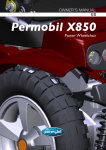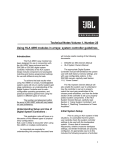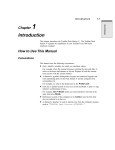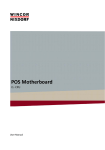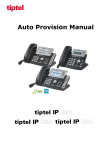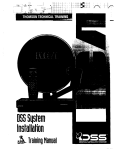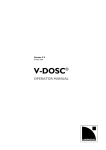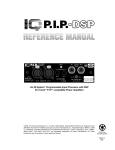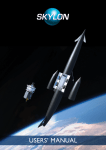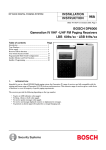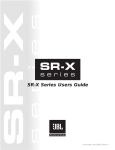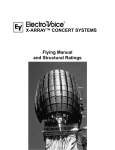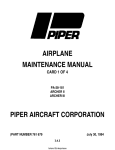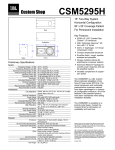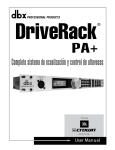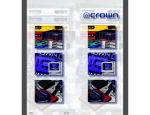Download Horn Loaded Array System Manual
Transcript
HLA 4895 & 4897 Horn Loaded Array System Owner Manual Cover photo taken at Werchter Music Festival July 5, 1997. EML Belgium provided 48 HLA 4895s and 24 HLA 4897s for coverage of 50,000 European music fans. Photo credit: Bill Gelow; Guy Hawley photo model. Table of Contents Section 1. Introduction and system overview Page 12 Section 2. Getting started with system setup Page 13 Section 3. Using system controllers Page 17 Section 4. Matching transducers to power amplifiers Page 15 Section 5. Input / output connector panels and cabling Page 17 Section 6. HLA system array design setups Page 19 Section 7. Hanging and rigging information for HLA arrays Page 29 Section 8. System transport and truck-pack information Page 32 Section 9. System maintenance and repair tips Page 35 Appendix A, HLA Polarity Issues Page 42 Appendix B, DSC280 system controller settings Page 43 Appendix C, Available JBL parts and accessories Page 44 Appendix D, Supplemental Info - ATM Fly-WareTM Page 45 Appendix E, Additional information resources Page 46 Appendix F, Typical HLA Array Setups Page 47 1 HLA System Owner Manual Section 1. - INTRODUCTION AND SYSTEM OVERVIEW Congratulations on purchasing the latest in sound reinforcement speaker technology from JBL Professional. HLA’s high acoustical power output capabilities and pattern-controlled coverage characteristics allow fewer speakers to achieve superior results with significant weight savings when compared to systems that rely on traditional speaker technology. HLA’s superior performance is derived from not one, but a collection of several new technologies, each offering a unique advantage over conventional speaker designs. HLA’s New Technologies Differential Coil Drive (DCD) New voice coil and motor assemblies have twice the thermal surface area of traditional speakers. This enables HLA systems to provide higher peak output with less power compression, better heat dissipation and a flatter impedance curve at higher frequencies. These transducers are one-third the weight of a traditional speaker, with 16-ohm impedance ratings which enable more efficient use of today’s high-powered amplifiers. Direct cooling of DCD drivers provides a simple method for greater thermal transfer of heat away from the voice coil. This allows for long-term high-power operation. Composite magazine A non-wood speaker enclosure made of space-age man-made material contributes lighter overall system weight and improved rigidity. Benefits include better transducer loading for low distortion, direct cooling, and weather resistance. MultiBand WaveguideTM Triple-section horn combines low, midrange and high-frequency waveguides into a single device, offering wide-band acoustical pattern control with low distortion, and reduced interference from adjacent elements. The benefit: better-sounding loudspeaker arrays. SpaceframeTM A rigid aluminum frame structure that distributes weight and lifting stress, enabling pull tests of 25,000 pounds (11,400 kg) without failure or structural deformation. The Waveguide is tiltable within Spaceframe. Linear Dynamics ApertureTM Contoured subwoofer ports virtually eliminate high-level turbulence found in traditional subwoofer port designs. At 25 Hz, this provides for 8 dB less port compression at full output, and offers 3 dB greater output than conventional subwoofers. Approximately one-half the number of HLA Model 4897 subwoofers will typically be required for equivalent acoustical output compared to conventional subwoofers. Any of the above technical innovations would give a sound system a competitive advantage. JBL’s HLA system combines them to provide an unprecedented high-performance package for portable sound reinforcement. 2 Section 2. - GETTING STARTED WITH SYSTEM SETUP The 4895 three-way HLA full-range speaker has a shipping weight of 230 pounds (105 kg). The 4897 dual-eighteen HLA subwoofer speaker, shipping weight of 240 pounds (110 kg). Both speakers are shipped wrapped in cardboard and fit two per shipping pallet. At least one 4897 subwoofer is recommended for every two 4895 full-range speakers. HLA Model 4895 Three-Way HLA Model 4897 Subwoofer Wheel Bars (HLA-WHEELS) are used for moving portable or touring HLA speaker systems. Each speaker can be ordered with pairs of Wheel Bars for use in moving HLA speakers from the truck or storage to the position in the venue where the array will be assembled. A Wheel Bar is a 34-inch (86 cm) long L-shaped aluminum extrusion with two wheel-castors mounted. Two Wheel Bars slide into guides along each side of the bottom of the speaker from the back. Wheel Bars are shipped in pairs in a cardboard box weighing 25 lbs. (11 kg). Connecting and lifting hardware Connecting Bars (HLA-CB) are used in pairs to link one speaker to another. With one speaker suspended above another, a Connecting Bar slides into both speakers’ guides, one Connecting Bar on each side. Two Connecting Bars are needed for every speaker that is not in the top row of a speaker array. Lifting Bars (HLA-LB) are used in pairs to connect each speaker in the top row of an array to the individual Truss Module above it with 1/2-inch screw pin anchor (SPA) Shackles. Lifting Bars slide into the two guides on either side of the top of the speaker and each has two reinforced holes to accept suspension clips, or Shackles. Two Lifting Bars are needed for every speaker in the top row of a hanging speaker array. This is the only approved method for hanging HLA speakers. Four 1/2-inch SPA Shackles or load-rated safety-hook assemblies can be used to attach an HLA-LB to the Truss Module above it (see Section 6, “Hanging and rigging information for HLA arrays”). 3 HLA-CB (Connecting Bar) HLA-CA, HLA-LB, and HLA-WHEELS Connecting Bars and Lifting Bars are both black I-shaped aluminum bars that are 2.5 inches (6 cm) tall, 3/16 inches (5 mm) thick and 34 inches (86 cm) long. Lifting Bars and Connecting Bars are sold by JBL in pairs. Shipping weight is 7 lbs. (3 kg) per pair. Speaker input signals: the system controller The recommended system controller is the DSC280 Digital System Controller, which provides processing for a stereo HLA speaker system. It is factory-loaded with presets that include the correct adjustments for several different array configurations. The DSC280 is two rack-spaces (3.5 inches) high, 14 inches (36 cm) deep and weighs 16 lbs. (7 kg). (See Section 3, “Using System Controllers”). The back panel of the DSC280 has 2 female XLR input connectors, and two sets of four male XLR output connectors, one for each band pass of a stereo system, for a total of 8 male XLR outputs. If the DSC280 is located close to the power amplifiers, 8 short XLR cables will connect them. If the DSC280 is located at a control position removed from the amplifiers’ location, 8 balanced (3wire) cables are needed to connect them. This can be accomplished using 8 XLR return lines in the microphone snake, or preferably by using a separate, dedicated multi-pair cable with at least 8 channels total, terminating inside the racks with XLR connectors. A stereo HLA system requires 8 distinct channels of amplification, two channels for each band-pass output. The subs, lows, midrange and high-frequency amplifier channels should be able to cleanly provide a minimum of 1,600, 2,400, 1,600 and 800 watts respectively into four ohm loads. Three stereo amplifiers with sufficient power, one each for lows, mids and highs, will work with eight 4895 three-way speakers, driving four 16-ohm transducers on each channel. Two additional amplifiers will power four 4897 subs, with two 8-ohm transducers on each channel. Five amplifiers running 4-ohm loads can power a basic HLA block of eight 4895 speakers and four 4897 subs if the amplifiers can provide the required power for each type of transducer (See Section 4, “Matching transducers to power amplifiers”). 4 Typical HLA System Configuration showing controller, amplifiers and loudspeakers 5 HLA Series Basic Module One Channel Shown Output A Output B Output C Output D MPX1200, Bridged Mode MPX1200, Bridged Mode MPX1200, Bridged mode MPX1200, Stereo mode MPA600, Stereo mode LF JBL 4897 JBL 4895 MF HF Spare Amplifier Channels to be used for additional Speakers Loop-through Connections The HLA 4895 speakers and 4897 subwoofers come standard with Neutrik NL-8 Speakon connectors. The NL-8 Speakon connector has four pairs of speaker connections, but the two speaker models have different circuit assignments. A different but identical speaker cable can be used for the two kinds of HLA speakers. Each 4897 sub-woofer is cabled individually to its amplifier channel. Note: only one of every four 4895 three-way speakers must be cabled to the amplifiers. Up to three more 4895 speakers can be connected in parallel to the first with short jumper cables. Speaker cables that will reach from the amp rack are needed for each 4895 subwoofer. Only one speaker cable that will reach from the amp rack is needed for one of every four 4895 speakers, and short jumpers are used to connect the remaining three out of four 4895 speakers together in parallel. 6 Section 3. - USING SYSTEM CONTROLLERS JBL’s HLA system requires the use of precision-adjusted system controllers for best results. These devices combine crossover, signal delay, equalization and limiting functions in a single digitally-controlled analog signal processing package. The DSC280 system controller from JBL Professional is recommended for use with the HLA system. Alternatively, a pair of DSC260 system controllers can be used, or a single DSC260 can be used for 4895’s in fill or delay speaker applications. DSC280 Digital System Controller DSC260 Digital System Controller Using the Model DSC280 Digital System Controller The DSC280 is a stereo 4-way programmable speaker controller with 60 memory locations. Refer to the DSC-280 User Manual for complete operating instructions. On the left of the front panel of the unit, each output has 8-segment LED signal meters and a mute switch. On the right is the control screen surrounded by its menu keys, function keys, and cursor control. The Edit key at the bottom right steps through the four display screens for each preset. The Utility key displays the utility menu that corresponds to each of the four display screens. The Menu keys to the left of the screen are assigned functions that are labeled on each screen. The Store and Recall keys are also used for comparing changes made while in Edit mode There are two switches that control the left and right linking of control. Users are cautioned against accidentally adjusting only side of the system by inadvertently touching both buttons at once. To operate both sides of a stereo system in the same manner, make sure that both the “L” and “R” indicators are lit at all times. Multiple system files The DSC280 digital controller has 60 user-programmable memories and files with pre-programmed settings for different JBL products. HLA pre-sets are stored starting in memory location 20. The memory number is indicated in the upper left corner of the display screen. Each of these files is set to fine tune the system for particular configurations. Memory locations for different configurations of HLA arrays: 7 DSC280 Memory # Array Configuration (4895 + 4897) 12 HLA SML 1+1 13 HLA 2x2 2+2 14 HLA 2x3 4+2 15 HLA 3x3 6+3 16 HLA 4x4 10+6 17 HLA 4x4 10+10 (extra subs) The first preset in location #12 has less HF boost for shorter-distance applications of one 4895 and one 4897, intended for small-space demonstration only. Subsequent presets are for longer-distance, actual use situations. Other presets can easily be configured by recalling one that is close to the desired performance characteristics and then modifying it. For example, a preset for a 6 + 3 array (six 4895 speakers and three 4897 subwoofers) can be created by recalling location #15 (6 + 3) and then adjusting the output gain levels of each crossover bandpass (lows, mids, highs, etc.) as required. Note that system tuning in DSC280 Memory Location #17 is the same 4x4 array as in #16, but with additional subwoofers on the ground. DSC280 Display Screen Four display screens. There is one default display screen that shows the combined response curves of the output bands, plus three more display screens for inspecting and adjusting delay, equalization, and crossover parameters. Each band output has parameters for setting parametric EQ, delay, phase and polarity. Some of these are used to pre-set the system and, along with the crossover parameters, are locked in system software. Parameters that are critical to HLA performance are locked into the OEM program and blanked out from being displayed. Delay Display. The delay screen has adjustments for individual Band outputs and the overall system delay, since the subwoofers may not always be placed in alignment with the 4895 three-way speaker and thus could need minor adjustments. The signal delay adjustments for the three transducers in the 4895 three-way speaker are linked and locked, since all three transducers are physically aligned in the same speaker. Four Utility Menus. Each of the four display screens (Main, Delay, EQ and Xover) has its own utility menu screen for inspecting and modifying additional parameters related to each display screen. From the Delay utility menu, units for delay adjustment can be selected as milliseconds (ms), feet (ft) or meters (m). 8 EQ. Some filters have been used for important system optimization e.q. and are in OEM lock mode. Each output has up to two parametric equalization filters that can be assigned. The other frequencies in each band can be adjusted by the user. Xover. The crossover settings are symmetrical 24 dB/octave slopes set at 120, 297 and 1.14kHz. The subwoofer’s high-pass is set at 28 Hz. These are locked by the OEM programmer to prevent damage. Each output band’s level can be adjusted + or - 15 dB. The gain for each pass band should be adjusted in reference to the power amplifiers in use (See Chart, “Recommended DSC280 Settings”). Limiters. Each output band’s limiter should be adjusted to fit the power amplifiers that are being used. These limiters must be carefully set to protect the drivers in each band, particularly the Highs (band D). The limiters must be set for the gain and sensitivity of the model of amplifier used in each band. From the Xover Utility menu screen the Sub band outputs can be summed together in mono on this screen and this is also indicated by an LED on the left of the front panel when engaged. (Also notice an LED indicator on the far left to show when the +10 dB input boost switch, located on the back between the XLR inputs, is engaged.) The units in which the output band limiters are set can be changed to either millivolts (mV) or dBu on this screen. On the default screen’s Utility menu there is a Lock mode control as the third item in the first column. With the Lock Mode set to ON, the name and number of the current preset is displayed along with the JBL startup screen and only the current preset operates. Those familiar with the DSC will find it easy to turn off the Lock mode from the default Utility screen. With the Lock mode set to OFF, user-level access allows recall of other presets, modification of all parameters left unlocked by the OEM programmer, except the limiters if the Owner’s lock is engaged. WARNING: Misadjustment of the DSC280’s limiters can allow transducers to be damaged under high-power conditions. These parameters should only be modified by knowledgeable users, then Owner locked to prevent transducer damage or degraded sound quality. When the Owner lock is engaged these parameters cannot be seen or adjusted. Owner lock and bandpass limiters The Owner lock is engaged when the word “Owner” appears in the lower left corner of the display screen. Changing the Owner lock is done from the default utility screen by placing the cursor in the Lock parameter and toggling the up cursor once or twice until the DSC asks for a four-letter password (shipped as “DSC”). If you change the password, be sure to make a note of it as problems may result if you forget it. The Owner lock restricts parameter access to only recalling presets and modifying them as allowed by 9 the OEM design, excluding the limiter settings. Files cannot be deleted and the default, or “blank slate” preset in memory location 0 cannot be recalled. It is recommended that the password be changed to something unique and meaningful that will easily be remembered by those responsible for the system. When a knowledgeable technician is not present, it is recommended that the Owner lock be engaged, as it still offers a generous amount of system control adjustment. If the system will be left in the care of curious yet unqualified operators, it is recommended that only presets for the current speakers and amplifiers be left in memory and the Owner lock be engaged. In this way only valid presets can be recalled and operated. Presets can be deleted by disengaging the Owner lock, pressing Recall and then Utility to get to the Delete File soft key. Each output band has a mid-band limiter. Disastrous results can occur if the limits are set incorrectly, either too high, too low, or not at all. Limiters should be carefully set for the gain and sensitivity of the specific amplifier used in each band. (See Section #4, “Matching Transducers to Power Amplifiers). HLA speakers can be used with a variety of professional power amplifiers and it is not possible to know in advance which amplifiers may be chosen by a particular owner. The limiter engages when each bandpass output’s signal reaches the set limit, either in millivolts or dBu (with 775 millivolts equal to 0 dBu). By first choosing an output level for the limiter and then gauging the maximum amount of power this will allow the amplifiers to feed to the transducers, the limiters can then be safely set for the rigorous demands of contemporary live music. Frequency Section on DSC280 Band A Band B Band C Band D System Bandpass HLA System Component Subwoofer Low Frequency Mid Frequency High Frequency 2242HPL 2254J 2251J 2451SLJ Maximum Input Voltage Recommended 72 volts RMS, 144v Peak 98 volts RMS, 196v Peak 80 volts RMS, 160v Peak 24.4 volts RMS,60v Peak Careful calculations should be made prior to using the system, to correctly set the limiters. For protection, this can only be done with the Owner lock released. After the limiters are set for use with the specific amplifiers chosen for the system, their presets should be re-stored to preserve them. If the only files in the DSC are HLA presets with the limits correctly set for the amplifiers, no other presets can be run with the Owner lock engaged. With the Owner lock engaged, files cannot be deleted, the default program cannot be recalled and limiters cannot be adjusted. 10 If amplifiers go into clipping, either the limiter setting should be lowered or the amplifier must be replaced with a more powerful model. Limit settings should be carefully re-examined whenever the make or model of amp used for an output band is changed and Gain parameters may also need to be changed. Limiter thresholds and Gain (drive level settings) are two different parameters. The Gain output for individual bands can be increased or decreased by +/- 15 dB in 0.2 dB steps for balancing the band outputs. The output limiter threshold value remains set independently of the output gain. IMPORTANT: Different amplifier makes and models can have different gain and input sensitivity. Consult the particular amplifier’s specifications for input sensitivity ratings. Amplifiers with switchable input sensitivity should be set for 0.775 volts = 0 dBu. At this sensitivity the limiter settings can be calculated by reducing the number of dB from the maximum amplifier output to match the driver’s AES power rating. 11 PCMCIA cards There is a PCMCIA card slot underneath the top cover in the front, left corner of the DSC280 unit. HLA files stored to a PCMCIA card can be loaded into the unit. This makes an excellent field method for confidently and accurately updating system characteristics for the DSC280 that have been carefully worked out in a controlled environment such as a test bench or system warehouse. After the cover has been removed and a card has been inserted, press “RECALL” while in the default screen. Press the middle soft key on the left of the display. Use the up or down cursor key to make the middle soft key show “Cprg” ( Card program). Press the top soft key (“PICK”) and press the up or down cursor key to select the program from the card. A second press of Recall will load the program. The preset should now be stored in the DSC280’s internal memory for future use. MIDI command information bulk dump The controls for performing a MIDI bulk dump are located on the Utility menu of the default screen. This operation copies all data from one DSC280 into another via a MIDI cable connecting the two units. Instructions are found on page 19 of the DSC280 manual. For more detailed information on using the DSC280, refer to the User Manual. Using the Model DSC260 Digital System Controller A cost-effective alternative to the DSC280 is the DSC260. It is a single rack space, two-channel digital controller with six outputs assignable to either or both inputs. As such it may be used as an HLA system controller for 4895’s only. For example, it is well-suited for applications where it will reside in a dedicated amplifier rack to provide control for a group of 4895 speakers. This application may be useful when setting up dedicated down-, front-, near-fill or delay speaker systems. It can also be used as a dedicated controller for subwoofers on a separate console output. When using 4895’s and 4897’s together, a pair of DSC260’s will offer full stereo system control, with one unit handling the left and right feeds to the three-way 4895’s and the second unit handling subwoofer feeds to the 4897’s. In the DSC260, Over 600 milliseconds of delay can be assigned in 21 microsecond increments. A budget of up to 30 bands of parametric equalization can be assigned to the inputs or outputs, depending on the slopes of the assigned crossovers. Permanent installations will benefit from this additional equalization as the DSC260 can be used for all room e.q. adjustments. Like the DSC280, output limiters on the DSC260 can be set for each band. Gain levels can be adjusted from -30 to +10 dB. “MIDI sysex dump” can be used to save and transfer presets between units and to archive settings. On the left of the front panel of the DSC260 there are six Mute keys for the outputs, along with foursegment LED bargraph metering on the outputs and on the two inputs. On the right of the front panel is a 2 x 16 character LCD display screen. The bottom line of the display shows the program number and the name of the stored program. To the left of this display are the parameter increment and decrement keys, labeled “+” and “-” and used for adjusting individual parameters. Next to these there are keys to Store and Recall presets, also used to confirm certain operations. To the right of the display are four access buttons for moving the display through the locations on the parameter grid. For more detailed information on using the DSC260, consult the DSC260 Owners Manual. 12 Suggested Power Amplifier Passband Amplifier Mode DSC280 Controller Settings DSC280 Gain Settings Power Amp Gain DSC Limiters Memory12 Memory13 Memory14 Memory15 Memory16 Memory17 JBL HF MPA 600 Stereo 75 35 dB -2.0 dBu -8 dB -7 dB -6 dB -5 dB -5 dB -6 dB MF MPA 1100 Bridged 400 44 dB -3.3 dBu -9 dB -6 dB -6 dB -5 dB -5 dB -8 dB LF MPA 1100 Bridged 600 44 dB -1.6 dBu -6 dB -6 dB -4 dB -6 dB -6 dB -3 dB Sub MPA 1100 Bridged 2 x 800 44 dB -3.3 dBu -4 dB -4 dB -4 dB -4 dB -4 dB -4 dB HF MPX 600 Stereo 75 35 dB -2.0 dBu -8 dB -7 dB -6 dB -5 dB -5 dB -6 dB MF MPX 1200 Bridged 400 44 dB -3.8 dBu -9 dB -6 dB -6 dB -5 dB -5 dB -8 dB LF MPX 1200 Bridged 600 44 dB -2.0 dBu -6 dB -6 dB -4 dB -6 dB -6 dB -3 dB Sub MPX 1200 Mono 2 x 800 38 dB -2.2 dBu -2 dB -2 dB -2 dB -2 dB -2 dB -2 dB HF 6670 Stereo 75 32 dB -1.0dBu -5 dB -4 dB -3 dB -2 dB -2 dB -3 dB MF 6670 Bridged 400 38 dB -2.2 dBu -3 dB -0 dB -0 dB -1 dB -1 dB -2 dB LF 6670 Bridged 600 38 dB -4.0 dBu -0 dB -0 dB -2 dB -0 dB -0 dB -3 dB Sub 6670 Bridged 2 x 800 38 dB -2.2 dBu -2 dB -2 dB -2 dB -2 dB -2 dB -2 dB HF K2 Max Stereo 75 33 dB -0.1 dBu -6 dB -5 dB -4 dB -3 dB -3 dB -4 dB MF K2 Max Bridged 400 39 dB -1.4 dBu -4 dB -1 dB -1 dB -0 dB -0 dB -3 dB LF K2 Max Bridged 600 39 dB -3.1 dBu -1 dB -1 dB -1 dB -1 dB -1 dB -2 dB Sub K2 Max Bridged 2 x 800 39 dB -1.4 dBu -1 dB -1 dB -1 dB -1 dB -1 dB -1 dB HF M-T 2400 Stereo 75 38 dB -5.4 dBu -11 dB -10 dB -9 dB -8 dB -8 dB -9 dB MF M-T 5000VZ Stereo 400 42 dB -2.1 dBu -7 dB -4 dB -4 dB -3 dB -3 dB -6 dB LF M-T 5000VZ Stereo 600 37 dB 4.8 dBu -1 dB -1 dB -3 dB -1 dB -1 dB -4 dB Sub M-T 3600VZ Mono 2 x 800 42 dB -1.6 dBu -2 dB -2 dB -2 dB -2 dB -2 dB -2 dB Crown .775v Sensitivity 1.4V Sensitivity HF M-T 2400 Stereo 75 33 dB -0.3 dBu -6 dB -5 dB -4 dB -3 dB -3 dB -4 dB MF M-T 5000VZ Stereo 400 37 dB -3.0 dBu -2 dB -1 dB -1 dB -2 dB -2 dB -1 dB LF M-T 5000VZ Stereo 600 37 dB -4.8 dBu -1 dB -1 dB -3 dB -1 dB -1 dB 4 dB Sub M-T 3600VZ Mono 2 x 800 37 dB -3.5 dBu -3 dB -3 dB -3 dB -3 dB -3 dB 3 dB HF 7001 Stereo 75 32 dB -1.0 dBu -5 dB -4 dB -3 dB -2 dB -2 dB -3 dB MF 9001 Stereo 400 32 dB -8.2 dBu -3 dB -6 dB -6 dB -7 dB -7 dB -4 dB LF 9001 Bridged Sub 9001 Mono Crest 600 38 dB -4.0 dBu -0 dB -0 dB -2 dB -0 dB -0 dB -3 dB 2 x 800 32 dB -8 dB -8 dB -8 dB -8 dB -8 dB -8 dB -8 dB QSC Powerlight HF 2.0 Stereo 76 36 dB -2.9 dBu -9 dB -8 dB -7 dB -6 dB -6 dB -7 dB MF 4.0 Stereo 400 38 dB -2.2 dBu -3 dB -0 dB -0 dB -1 dB -1 dB -2 dB LF 8.0 Stereo 600 40 dB -1.7 dBu -2 dB -2 dB -0 dB -2 dB -2 dB -1 dB LF 3.4 Bridged 600 44 dB -1.9 dBu -6 dB -6 dB -4 dB -6 dB -6 dB -3 dB Sub 8.0 Mono 2 x 800 40 dB -0.0 dBu -0 dB -0 dB -0 dB -0 dB -0 dB -0 dB Note: All calculations are based on the HLA data sheet power ratings for the drivers in each section. 13 Suggested Power Amplifier Passband Amplifier Mode DSC260 Controller Settings DSC260 Gain Settings Gain Settings (dedicated 2nd unit required for subwoofers) Power Amp Gain DSC Limiters (Small) (2 + 1) (4 + 2) (6 + 3) (10 + 6) (12 + 6) JBL HF MPA 600 Stereo 75 35 dB -2.0 dBu -18 dB -17 dB -16 dB -15 dB -15 dB -16 dB MF MPA 1100 Bridged 400 44 dB -3.3 dBu -19 dB -16 dB -16 dB -15 dB -15 dB -18 dB LF MPA 1100 Bridged 600 44 dB -1.6 dBu -16 dB -16 dB -14 dB -16 dB -16 dB -13 dB Sub MPA 1100 Bridged 2 x 800 44 dB -3.3 dBu -14 dB -14 dB -14 dB -14 dB -14 dB -14 dB HF MPX 600 Stereo 75 35 dB -2.0 dBu -18 dB -17 dB -16 dB -15 dB -15 dB -16 dB MF MPX 1200 Bridged 400 44 dB -3.8 dBu -19 dB -16 dB -16 dB -15 dB -15 dB -18 dB LF MPX 1200 Bridged 600 44 dB -2.0 dBu -16 dB -16 dB -14 dB -16 dB -16 dB -13 dB Sub MPX 1200 Mono 2 x 800 38 dB -2.2 dBu -18 dB -18 dB -18 dB -18 dB -18 dB -18 dB HF 6670 Stereo 75 32 dB -1.0 dBu -15 dB -14 dB -13 dB -12 dB -12 dB -13 dB MF 6670 Bridged 400 38 dB -2.2 dBu -13 dB -10 dB -10 dB -19 dB -19 dB -12 dB LF 6670 Bridged 600 38 dB -4.0 dBu -10 dB -10 dB -18 dB -10 dB -10 dB -17 dB Sub 6670 Bridged 2 x 800 38 dB -2.2 dBu -18 dB -18 dB -18 dB -18 dB -18 dB -18 dB HF K2 Max Stereo 75 33 dB 0.1 dBu -16 dB -15 dB -14 dB -13 dB -13 dB -14 dB MF K2 Max Bridged 400 39 dB 1.4 dBu -14 dB -11 dB -11 dB -10 dB -10 dB -13 dB LF K2 Max Bridged 600 39 dB 3.1 dBu -11 dB -11 dB -19 dB -11 dB -11 dB -18 dB Sub K2 Max Bridged 2 x 800 39 dB 1.4 dBu -19 dB -19 dB -19 dB -19 dB -19 dB -19 dB HF M-T 2400 Stereo 75 38 dB -5.4 dBu -21 dB -20 dB -19 dB -18 dB -18 dB -19 dB MF M-T 5000VZ Stereo 400 42 dB -2.1 dBu -17 dB -14 dB -14 dB -13 dB -13 dB -16 dB LF M-T 5000VZ Stereo 600 37 dB -4.8 dBu -19 dB -19 dB -17 dB -19 dB -19 dB -16 dB Sub M-T 3600VZ Mono 2 x 800 42 dB -1.6 dBu -12 dB -12 dB -12 dB -12 dB -12 dB -12 dB Crown .775v Sensitivity 1.4V Sensitivity HF M-T 2400 Stereo 75 33 dB -0.3 dBu -16 dB -15 dB -14 dB -13 dB -13 dB -14 dB MF M-T 5000VZ Stereo 400 37 dB -3.0 dBu -12 dB -19 dB -19 dB -18 dB -18 dB -11 dB LF M-T 5000VZ Stereo 600 37 dB -4.8 dBu -19 dB -19 dB -17 dB -19 dB -19 dB -16 dB Sub M-T 3600VZ Mono 2 x 800 37 dB -3.5 dBu -17 dB -17 dB -17 dB -17 dB -17 dB -17 dB HF 7001 Stereo 75 32 dB -1.0 dBu -15 dB -14 dB -13 dB -12 dB -12 dB -13 dB MF 9001 Stereo 400 32 dB -8.2 dBu -17 dB -14 dB -14 dB -13 dB -13 dB -16 dB LF 9001 Bridged Sub 9001 Mono HF 2.0 MF 4.0 LF LF Sub Crest 600 38 dB -4.0 dBu -10 dB -10 dB -18 dB -10 dB -10 dB -17 dB 2 x 800 32 dB -8 dB -12 dB -12 dB -12 dB -12 dB -v2 dB -12 dB Stereo 76 36 dB -2.9 dBu -19 dB -18 dB -17 dB -16 dB -16 dB -17 dB Stereo 400 38 dB -2.2 dBu -13 dB -10 dB -10 dB -19 dB -19 dB -12 dB 8.0 Stereo 600 40 dB -1.7 dBu -12 dB -12 dB -10 dB -12 dB -12 dB -19 dB 3.4 Bridged 600 44 dB -1.9 dBu -16 dB -16 dB -14 dB -16 dB -16 dB -13 dB 8.0 Mono 2 x 800 40 dB -0.0 dBu -10 dB -10 dB -10 dB -10 dB -10 dB -10 dB QSC Powerlight Note: All calculations based on the HLA data sheet power ratings for the drivers in each section. 14 Section 4. - MATCHING TRANSDUCERS TO POWER AMPLIFIERS Transducers used in JBL’s HLA system are conservatively rated. Each transducer in an HLA system has been tested with pink noise with a crest factor of 6 dB, over its intended range, simulating realistic operating conditions with music program peaks of four times the RMS power. Power is calculated based on a minimum impedance (when the driver is cold) and the RMS voltage of the noise input signal. The AES specification used by JBL requires the transducer to operate at this level for 2 hours with no degradation in performance. It is recommended that amplifiers have a peak output capacity of double the RMS power rating at full power, taking amplifier dynamic headroom into account, to avoid clipping the signal. For this reason maximum Recommended Power Levels per Transducer (RPL/T) exceed the AES power rating of individual drivers. Transducer specifications and power levels: Frequency Band SUB LF MF HF HLA Driver 2242HPL 2254J 2251J 2451SLJ Frequency, in Hz 35-120 120-297 297-1.14k 1.14-16k Impedance 8 ohms 16 ohms 16 ohms 16 ohms AES power rating 800 W 600 W 400 W 75 W RPL/T 1,000 W 700 W 500 W 200 W Sensitivity, 1w/1m 98 dB 107 dB 107 dB 116dB Power amplifier requirements for HLA system Four 4895 three-way speaker systems need only three channels of amplification, one for each output band. Each band uses 16-ohm transducers, and four paralleled transducers represent a 4-ohm load. A 4897 subwoofer requires a single channel of amplifier power. 4897 subwoofers use two 8-ohm transducers with separate Speakon circuit connections. One 4897 subwoofer presents a 4-ohm load to a power amplifier, with its two transducers in parallel. Choosing the correct amplifier for each bandpass. The 4897 subwoofer uses two 8-ohm transducers with separate pin-outs for maximum energy transfer. The subwoofer amp should be capable of 1,600 to 2,400 watts output into four ohms. The use of 16-ohm transducers in the 4895 speakers allows four drivers in each band pass to be driven in parallel from an amplifier running at 4 ohms, for efficient use of amplifiers. The suggested minimum number of HLA units recommended by JBL to be used together in a system are qty. four HLA-4895’s and qty. two HLA-4897’s. This quantity of loudspeakers is called an “Array Module”. A minimum of two array modules would be used for a stereo (left/right) system. Four 4895 three-way speakers will need three channels of four-ohm power at these power ratings: 15 Lows: 2,000 - 3,200 watts Midrange: 1,200 - 2,400 watts High-frequency: 600 - 800 watts As few as five stereo amps can power eight 4895 speakers plus four 4897 subs at four ohms. Four-ohm loads and amplifier performance The HLA Array Module is designed to present 4-ohm loads to the amplifiers. Many amplifiers are capable of running two-ohm loads for extended periods of time. Users intending to run loads lower than four ohms should consult with the manufacturer and carefully consider the power available per transducer and the distortion specification at the amplifier’s two-ohm rating. Amplifiers can deliver a single (bridged) 4-ohm channel that is double its 8-ohm rating. Using a bridged amplifier requires twice as many amplifiers for that band’s output. CAUTION! System setup requires careful setting of the limiters for each band-pass to protect against transducer overload and amplifier clipping. See Section #3, “Using System Controllers”. Speaker High Freq 2451SLJ (125-400001-01) Diaph Repl D16R2451SL Speaker Mid Freq 2251J (114-31002-01) Cone Repl C16R2251 RED Connector Plate Assembly 129-00005-00 BLK WHT Speaker, Low Freq (2) 2242 HPL Cone Repl C8R2242 RED BLK Connector Plate Assembly 129-00006-00 BLK Speaker Low Freq 2254J (124-37005-00) Cone Repl C16R2254 GRN BLK RED BLK 16 Section 5. - INPUT / OUTPUT CONNECTOR PANELS AND CABLING Speaker cables terminate at the speakers with 8-conductor Neutrik NL-8 connectors. One cable reaches from the amplifiers to a single 4895 full range speaker. Short jumper cables then connect additional 4895 fullrange speakers in parallel to the first. Connecting 4 speakers in this manner divides the amplifier’s 4-ohm power by 4. One cable must reach from the amp rack to every 4897 subwoofer. Jumping sub-woofers in parallel reduces the amplifier’s damping characteristics and is not recommended. 4895 full-range speaker connections on the rear connector panel: Two (2) Neutrik NL-8 connectors in parallel are wired as follows : * Lows to conductor pair 2 +/-, * Midrange to conductor pair 3 +/-, * Highs to conductor pair 4 +/4897 sub-woofer connections on the rear connector panel: Two (2) Neutrik NL-8 connectors in parallel are wired as follows * First sub-woofer driver to conductor pair 1 +/* Second sub-woofer driver to conductor pair 2 +/Other connectors besides the Neutrik NL-8 can be custom-ordered. Examples include the ITT Cannon EP series of 4, 6 and 8-conductor connectors. JBL offers two cables to its customers: JBL Part No. 3805N 3850N Description 8-conductor 13-ga. Cable w/Neutrik connector 8-conductor 13-ga. Cable w/Neutrik connector Length 5 ft.* Use Array jumper cables 50 ft. Cross-stage cable and flying arrays (*Longer cable required for vertically-stacked 4895’s) NL-8 Speakon Couplers can be used to extend cables by joining two together. For flying array “mults”, custom harnesses can be fabricated using connectors from manufacturers such as Veam and Socapex. Multiconductor 12-gauge cable can be used with fan-out and fan-in NL-8 tails. Amplifier rack speaker cable panels with multi-conductor connectors can be wired with 3-foot (1 meter), 4-pair fan-out, with labeled and color-coded MDP banana jacks. The minimum recommended panel is 4 circuits of Neutrik NL-8 Speakon formatted as 2 circuits for 4895 full-range, and 2 circuits for 4897 subwoofer outputs. 17 Amplifier rack panels A labeled panel on the back of each amplifier rack fitted with individual female XLR connectors for each channel will put them in plain view for system technicians, and saves wear to the amplifiers’ connectors. Along with individual connections, multi-cable disconnects in parallel can be used to distribute signals in portable systems to make setup quick and infallible. By placing all signals onto pre-assigned channels of a multicore snake dedicated for sending signals to the amps, correct hookup is rapid and certain. Dedicated send snakes with 10 or 20 channels are common, with extra lines in the send snake often used for fill-in zones of speaker coverage, intercom and talk-back functions. Socapex fly-mult cables Rather than run several individual 8-conductor cables to a speaker array up in the air, another common cabling design is to run several circuits by using a 18-conductor cable with a Socapex-type connector such as is used widely in theatrical tour lighting. One Socapex cable can carry power for four 4897 subs and a second Socapex cable can carry power for two sets of four 4895 three-way speakers. At the back of the speaker array an adapter changes the standard Socapex multi-connection back into several Neutrik connectors to distribute power to the speakers: One Socapex-to-Speakon adapter fanning out to four 4897 subwoofer connections, while a second Socapex-to-Speakon adapter fans out to two 4895 speaker connections, for two groups of four 4895 speakers. At the amplifier racks, panels with the two different kinds of Socapex assignments are connected to the outputs of their respective amplifiers. Several companies in Europe have agreed on a circuit assignment design for accomplishing this in order to promote inter-vendor compatibility. Note the “Low” circuit doubles up conductors in the Socapex to allow for the higher current in that band of output. (There are other methods of organizing the Socapex circuits for this application.) EML European Socapex pin-out standard: Socapex Pin 11 12 13 14 15 16 17 18 19 10 11 12 13 14 15 16 17 18 (2) 4895 speakers - NL-8 pin 21 Low 11 Low 1` 2` Low 11 21 Low 1` 2` Mid 11 31 Mid 1` 3` High 11 41 High 1` 4` Low 21 21 Low 2` 2` Low 21 21 Low 2` 2` Mid 21 31 Mid 2` 3` High 21 41 High 2` 4` n. c. n. c. (4) 4897 subs - NL-8 pin Sub 11 11 Sub 11 21 Sub 1` 1` Sub 1` 2` Sub 21 11 Sub 21 21 Sub 2` 1` Sub 2` 2` Sub 31 11 Sub 31 21 Sub 3` 1` Sub 3` 2` Sub 41 11 Sub 41 21 Sub 4` 1` Sub 4` 2` n. c. n. c. 18 Section 6. - HANGING AND RIGGING INFORMATION FOR HLA ARRAYS Introduction This section provides instruction on what components are required to suspend HLA arrays, and how to connect them. The suspension points and hardware used to hang the array must meet applicable professional rigging standards. It is important to note that standards for hanging and rigging are local, not universal. It is also important for the user to contact appropriate regulatory agencies concerning relevant standards for specific applications. This document provides necessary information for the user to determine compliance with local or national standards but is not to be construed as a universal instruction guide for suspending loudspeaker systems. All parts constructed by JBL and ATM Flyware for use with the HLA system conform with known standards. For additional information on this topic, see JBL Technical Note Volume 1, Number 14. This document explains basic principles for suspending loudspeaker systems and provides further references on this specialized subject. Design and Weight Calculations HLA hardware is designed and certified with a 10:1 design ratio. For example, if the array weighs 2,000 lbs. (910 kg), all load-bearing components are capable of supporting at least 20,000 lbs. (9,100 kg) of static weight. Correct use of HLA hardware is required for secure array construction. Model 4895 and 4897 SpaceFrames with Lifting and Connecting Bars have been tested and rated for a working load limit of 25,000 lbs. (11,400 kg) per unit. No more than ten HLA speakers should be supported by HLA hardware. Careful calculations should be performed to ensure all components are used within their rated work load before the array is suspended. Remember: the weakest component determines the weight capacity of the entire array! WARNING! Before suspending any array, always inspect all components of the array for cracks, deformations, corrosion, and damaged or missing parts that could reduce strength and safety of the array. Use only load-rated hardware. Never exceed maximum load ratings at any time. Consult a licensed physical engineer if you are unsure how to proceed. 19 Hanging Array Components Four distinct components are required to link HLA speakers into a hanging array: 1) ATM MEGS-JBLHLA-T truss module (available direct from ATM FlyWare). 2) 1/2-inch SPA Shackles rated for 4,000 pounds (1,800 kg), also available from ATM. 3) JBL HLA-LB Lifting Bar 4) JBL HLA-CB Connecting Bar Chain from Hoist Inverted Electric Chain Hoist OR Other appropriate suspension method Chain or Wire Rope Bridle Wire Rope, Spansets, Shackles, etc. connected to appropriate connection point ATM MEGS HOIST (1 per MEGS JBLHLA-T, included) (is not JBL Product) ATM MEGS JBLHLA-T (1 per Column of Speakers) (is not JBL Product) HLA Loudspeaker 1/2" Crosby Shackles (4 per MEGS JBLHLA-T) (is not JBL Product) JBL HLA-LB Lifting Bar (2 needed per column of speakers) JBL HLA-CB Connecting Bar (2 needed per attached speaker) 20 The following tables will assist in determining the proper number of parts to use when assembling HLA speaker arrays. To determine how many HLA-CB’s (Connecting Bars) are required: # of HLA UNITS IN ARRAY 8 12 16 24 NUMBER OF HLA-CB’s TO USE 4 pair (8 total connecting bars) 8 pair (16 total connecting bars) 12 pair (24 total connecting bars) 18 pair (36 total connecting bars) To determine how many HLA-LB’s (Lifting Bars) are required: HLA VERTICAL COLUMNS TO LIFT 4 6 8 10 NUMBER OF HLA-LB’s TO USE 4 pair (8 total lifting bars) 6 pair (12 total lifting bars) 8 (16 total lifting bars) 10 pair (20 total lifting bars) To determine how many ATM FlyWare Truss Modules and Shackles to use: HLA VERTICAL COLUMNS TO LIFT 4 6 8 10 # ATM MEGS-JBLHLA-T TO ORDER 4 Truss Modules + (16) 1/2 inch shackles 6 Truss Modules + (24) 1/2-inch shackles 8 Truss Modules + (32) 1/2-inch shackles 10 Truss Modules + (40) 1/2-inch shackles HLA speaker assembly is designed to be quick and simple to assemble and suspend, but there are certain requirements about how they can be used. HLA was designed to be used in vertical columns. The speakers should not be suspended from the Spaceframe members, but rather must be only be suspended either from the Lifting Bar or directly below another speaker using a Connecting Bar. Up to ten degrees of forward vertical tilt of an array can be done. This will require ratchet straps for adjusting the correct angle. Thread the strap through the bottom rear section of each Spaceframe in the bottom row, then attach strap ends behind and outside the array. While suspending other materials from an HLA array is not necessarily unsafe, careful consideration should be made prior to doing so as there are many unforeseen approaches to suspending non-HLA products and devices that could endanger the integrity of the speakers and their ability to suspend each other. ATM supplies the part “MEGS-JBLHLA-T” 3x4 series truss module and it includes one upper hoist point at no extra cost (which ATM calls a “MEGS-SUSPEND”). The “MEGS-SUSPEND” can be seen on page 38 of the 1997 ATM catalog. It is the fitting on the left side of the lowest of the four line drawings. It is available separately for spare or replacement, but is not shown separately in the 1997 catalog. 21 The “MEGS-JBLHLA-T” product description on page 38 of the catalog says, “does not include suspension clips”. This refers to the required quantity of (4) 1/2-inch Shackles that clip into two holes on each Lifting Bar and are used to suspend it from the bottom of the Truss Module. ATM sells Crosby brand 1/2-inch Shackles (“suspension clips”) separately as part no. 1018455. These can be seen on page # 89 of the ATM 1997 catalog. Load-rated safety-hook assemblies can also be used in place of shackles. ATM advises that quick-release pins are available from vendors to substitute in place of graded bolts, and that truss module holes can be modified to accommodate these pins. Consult ATM Fly-Ware for additional information on use and assembly of truss modules. Array Construction Truss Modules connect the top row of speakers in an array to their suspension points. Typical touring and other temporary installations of flown arrays are accomplished with electrical chain hoist motors attached to structural beams. Chain hoist motors are typically manufactured with lifting capacities of either 1 or 2 tons. Calculations should be made to ensure the combined weight of the speakers and truss modules does not exceed the lifting capacity of the chain hoists that will be used (A 4895 weighs 220 lbs. (100 kg) and a 4897 sub-woofer weighs 230 lbs (105 kg). Each ATM MEGS-JBLHLA Truss module weighs 125 lbs. (57 kg). Array Weight Calculation Example : A Sixteen-unit array (4 rows, 4 columns), with (10) ea. 4895 speakers and (6) ea. 4897 subs should weigh: (10 x 220 lbs.) + (6 x 230 lbs.) + (4 x 125 lbs.) = 2,200 + 1,380 + 500 = 3,980 lbs. (1,809 kg). Two 1ton chain motors will typically be used in this situation. When connecting chain hoists to HLA truss modules, the motors are typically hung from points slightly farther apart than their corresponding pickup points below, thus keeping the array from swaying after it is suspended by the slight angle on the chains. Another method of hanging two points is to connect two wire rope slings coming down from the suspension points together by a heavy, rated chain whose length is the same as the distance between the two pickup points for the Truss modules. This creates an H-bridle from which the two motor chains will hang at the correct distance apart, dropping perpendicular to the floor from the H-bridle to the pickup points for the array. This places an angular stress on the points which does not change with trim, but may require more height. 22 When hanging an array from only two chain motors, choosing the orientation of the two suspension points will determine the horizontal coverage of the entire array. Choosing two points on a line parallel with the front of the stage will give equal coverage to each side of a perpendicular to the stage. Moving the off-stage (outside) hanging point up-stage (towards the back of the stage) will swing the coverage of the speaker array out, towards the sides, usually desirable in larger venues where seats wrap around the sides of the stage. Precisely locating the suspension points may require extra steel ropes and shackles to create bridles from available points that will reach the desired position over the ground. This process involves calculations for the materials and load that should only be performed by experienced professionals. Suspending an Array After chain-hoist motors have had their chains correctly attached to the suspension points, the motors can be raised off the ground and the Truss Modules can be hung from the chain hoist’s hook with slings. Slings can be made from either wire rope or synthetic polyester fiber (SpanSetTM). While fiber slings are lightweight, easy to handle and softer on equipment, their fire ratings are relatively poor compared to wire rope. Fire codes will vary - consult local authorities before installing fiber slings. Individual truss modules can be hung with a single vertical hitch from the chain motor’s hook to the truss module’s pick-up point on the hanger bar. Double-columns of speakers can be hung from a single motor with a bridle hitch using two separate short slings, with an angled leg connecting each truss module to the motor’s hook. All parts used to suspend the array must be rated for the load and angle at which they are being used. IMPORTANT NOTE: It is advisable to consult and engage a qualified rigger when making decisions related to purchase, setup and use of any equipment and techniques that will be used to suspend any temporary loudspeaker system above areas that will be occupied by persons. This equipment and general topical discussion is not to be taken as a working guide to configure specific arrays for individual conditions, which will vary considerably based upon the application. Seek specialized professional help when needed. 23 If the speaker array must move or is suspended above persons, proper safety techniques include the use of a redundant suspension system. Lifting points on the truss module can be chosen in different places that will affect the angle at which the entire array hangs. Lifting points can be positioned forward or back on the truss module(s) by attaching the hanger to the truss modules facing either forward or back. Lifting the array from a point behind its center of gravity will cause the array to tip forward. Hanging more rows of speakers will lessen this effect. Picking up the truss module group from inside points as shown in the above photo, rather than from outside points, will provide a cleaner hang by forcing the columns of speaker units to push in rather than out. Lifting a curved array that is several columns of speakers wide requires evaluation of the entire array’s center of gravity to achieve the desired angle at which the entire array will hang. Marking and labeling the assembly and connection points on the Truss Module will make it easier to repeat successful adjustments. 24 Lifting Bars with 1/2-inch screw pin anchor Shackles join the top array element to the truss module. Only load-rated forged carbon-steel shackles should be used for hanging an array. Screw pin anchor shackles come in a 1/2-inch size, which refers to the diameter of the body with the screw pin being 1/8-inch wider in diameter. The shackle’s load rating of 2,000 pounds should be stamped on the body of the shackle. Never use non-rated hardware for rigging. Never substitute bolts for shackle pins, as the pins are forged and are much stronger than bolts. Screw pin shackles should be finger-tightened only. If the shackle or pin is damaged, it is no longer safe and should be discarded. Shackles should always carry their load from the pin to the opposite end, never from side to side. After the top row of speakers has been connected to their Truss Modules, all hardware must be reinspected to see that it is securely in place. By lifting the first row of speakers a couple of inches off the ground, the way the speaker(s) hang from the motor(s) can be examined for the first time. Common industry practice dictates that, when using hoists or chain motors to lift weight, the motor operator should call out a loud warning to all nearby crew that the structure is “about to move” so that all hands and feet are clear of injury. Whenever the array is in motion, it must be clear underneath, with a well-defined safety zone. 25 Ensuring Proper Array Assembly If the top row’s connections are secure and satisfactorily placed, the array can be lifted to a height off the floor equal to the height of the next row of speakers on their wheels, about 56 inches (143 cm). This will be easy to gauge since the speakers going into the next row are nearby. The pairs of Wheel Bars on the bottom of each speaker slide out the back one at a time and at this working height of 5-1/2 feet (1.67 m), stage-hands do not need to bend over. After removing the wheels from the hung row, the next row is simply rolled into place beneath. After the next row is positioned under the suspended row above it, it may be necessary to lower the motors slightly. Again, be sure to call “about to move” to warn others whose hands or fingers may be in danger. When the speakers are directly over each other, the Connecting Bars slide into the guide tracks on each side of both speakers, one at a time, connecting them together. Insert the Quick Release Pins to secure the Connecting Bars. Subsequent rows of speakers are connected in similar fashion.] Lifting Bars (HLA-LB) and Connecting Bars (HLA-CB) are secured with quick release pins to ensure that bars stay securely in the track. All quick release pins must be fully inserted for positive locking. A quick release pin is attached to each Lifting or Connecting Bar with a wire cable to ensure they will be used together. Missing or damaged quick release pins should be replaced before using the Bars. The speaker cables, along with the control and power cable(s) to the motors should be secured in such a way that their weight does not hang on their connectors. This is can be done by cinching a long nylon sling around the back of the Truss module frame, wrapping it around all the cables twice and clipping it to itself with a shackle or a carabiner. If HLA speakers are suspended without the use of a Truss Module or similar suspension frame, care must be taken to hang the speakers so that their weight does not compress the Spaceframe. When connecting slings directly to the Lifting Bar without the Truss Module, bridles must be made front-to-back along the Lifting Bar, as this only places compression on the rigid Lifting Bar and not on the Spaceframe. As the array is being assembled, the chosen Tilt Angles can be selected for each 4895 Three-Way unit. Three positions are available...0°, 7.5°, and 15°. The tiltable waveguide is one of the most innovative aspects of the HLA system. It can be used to assemble precision-configured arrays that ensure smooth, even coverage to all parts of a listening area. A precisely-aimed 60-degree vertical coverage pattern can be obtained by tilting the waveguide on the upper array unit to its maximum of +15°, aiming the center 4895 unit straight ahead at 0°, and tilting the waveguide on the bottom 4895 unit at -15°. Arrays with varying coverage angles can be constructed by tilting waveguides as required. 26 Tilting the Waveguide The 4895’s Multiband Waveguide within the aluminum SpaceFrame has three orientations. In its upright position the Waveguide is parallel to the front of the SpaceFrame, with the drivers aiming horizontally. By releasing the plunger pin on the tilting mechanism at, the Waveguide pivots to two other locked positions, angling it back either 15 or 7.5 degrees vertically. This helps the top or bottom speakers in an array achieve the correct angle of coverage while constructing vertically connected columns of Spaceframes. Tilting the waveguide back causes the magazine to extend past the back of the Spaceframe. Waveguide, Normal Position Waveguide, 15-degree Tilt Position CAUTION! To avoid accident or injury, support the weight of the Waveguide and Magazine while releasing its lock. Care should be taken to keep fingers outside the Spaceframe and clear of the tilting mechanism. The combined weight of the waveguide and magazine is 100 lbs. (45 kg). Ground-stacked Array Construction Speaker arrays that are suspended in mid-air enjoy a significant advantage in their ability to cover a listening area evenly from front to back. However, it is not possible to suspend speaker arrays in every situation, due to various considerations and limitations. Speaker arrays can be deck-stacked on stage wings at the downstage corners of the stage, or raised above the plane of the stage by means of scaffolding, risers or additional speakers used to increase the height of the stacked speakers. Ground-supported arrays typically place sub-woofers on the bottom row and stack full range speakers 27 above on higher rows, employing improved front-to-back coverage afforded by the height advantage. A third stacked row enjoys an extra nine feet of height and can have MultiBand Waveguides tilted up for balcony coverage. The structural cross-bars in the Spaceframe and its light weight make it easy to lift and handle by as few as two able-bodied stage hands. Sliding Connecting Bars into place after stacking speakers helps to ensure their stability. Regardless of how HLA units are stacked or arrayed, keep in mind that the system will function as designed by JBL Engineers, and the most optimum performance will be obtained, when the units are deployed using a 2-to-1 ratio of 4895 three way units to 4897 subwoofers, and when each “array module” is positioned to couple the 14" Low Frequency units. 28 Section 7. - HLA SYSTEM ARRAY SETUPS The nominal horizontal coverage one HLA 4895 speaker unit is 40 degrees from 315 to 16,000 Hz. The nominal vertical coverage of one HLA 4895 speaker is 30 degrees from 315 to 16,000 Hz. The side angles of the HLA 4895 Spaceframe are constructed at 15 degrees to match the horizontal coverage pattern of its Waveguide to that of adjacent speakers in the same row for typical medium-sized venue applications.. This allows the construction of arrays that offer smooth, even horizontal coverage. HLA speakers can be configured several ways to achieve the required SPL and coverage. The horizontal angle between adjacent speakers in an array can be varied from 0 degrees, where neighboring speakers are facing into the same plane, to 30 degrees, where the horizontal angle of the speakers matches the angle on the sides of the Spaceframe. Optimum horizontal coverage will be obtained with a slight overlap between adjacent cabinets, as shown below. HLA Array Configurations and Adjustments Adjustment of adjacent HLA units can be made in increments of 5 degrees when using the MEGSJBLHLA Truss system to suspend the array. There are seven choices of horizontal splay angle afforded by the MEGS-JBLHLA Truss modules: 0, 5, 10, 15, 20, 25, and 30 degrees. At one extreme (0°) the speakers are facing into the same plane, increasing the amount of power delivered into the listening area at the expense of potential interference or “comb filtering” between the two speakers. On the other hand, if the two adjacent speakers are subwoofers, there will be increased coupling between them (resulting in increased apparent sound pressure levels) when they are facing into the same plane. This can be beneficial, and may be desirable in situations that demand the highest possible sound pressure levels within a defined area of coverage, such as music nightclubs and discotheques. At the other extreme the horizontal coverage of the speakers matches their side-angles, providing the 29 widest possible dispersion with minimal interference between adjacent speakers. At this extremely wide coverage angle only one speaker is heard at each listening position throughout the entire horizontal coverage of the array. The next increment of horizontal coverage opens the back corners of adjacent speakers by 5 degrees (25° splay). This optimum horizontal splay angle provides the smoothest, most transparent coverage using slight overlap. The response is even throughout the intended angle of horizontal coverage. This splay provides a horizontal coverage angle of 65 degrees from two adjacent speakers. Adding a third speaker at this angle increases coverage to about 97 degrees, and a fourth speaker at this angle increases coverage to 130 degrees horizontal. The entire Multiband Waveguide and its transducer magazine inside the aluminum SpaceFrame can be tilted 7.5 or 15 degrees. Tilting the waveguides in the top row of an array can increase vertical coverage of the array to 45 degrees. Inverting the 4895 speakers in the bottom row of an array allows waveguides in the bottom row to be angled down by 7.5 or 15 degrees. The vertical coverage angle can thus be increased to 45 degrees, with up to 30 degrees of down-wards coverage. Vertical coverage can increase to 45 degrees, with up to 30° of “down” coverage. (For additional information on this topic, see “Tilting the Waveguide” in Section 6) With the speakers in the bottom row inverted, both the top and bottom rows can be tilted in opposite directions tilted in opposite directions to extend their combined vertical coverage to 45°, 52.5°, or 60°, depending on the tilt angles used. Three rows of 4895 speakers in an array can provide vertical coverage through an angle of 60 degrees by inverting the bottom row of speakers and tilting the Waveguides in both the top and bottom row. Note: The 4895 and the 4897 subwoofer can be interchangeably combined in arrays. When 4897 subwoofers are used in multiples, the relative response at lower frequencies increases by 3 dB with each doubling of the number of units. 30 31 Section 8. - SYSTEM TRANSPORT AND TRUCK-PACK INFORMATION The HLA system is a global product. It is in use on nearly every continent, and is transported in a wide variety of ways including trucks, railroad cars, sea containers and air cargo modules. While the new product is often received packaged on a pallet for ease of handling, system users will develop their own unique ways of transporting HLA systems based on available transportation modes. Each speaker rides on four wheels that are attached two to each side on the bottom. Wheel dollies add 20 pounds (9 kg) to the weight of the speaker. Wheel dollies are two heavy-duty castors attached to a 34-inch (86 cm) L-shaped aluminum bar. Each Wheel dolly slides into a track on one side of the speaker’s bottom, from the back. Wheel dollies slide in at the same angle as the speaker’s side, so they must be removed or attached one at a time, sliding into the track from the back of the speaker. If the speakers are rolled backwards, the wheel dollies won’t slide out. The wheels at the front are 28 inches (71 cm) apart. Ramps that are 30 inches (76 cm) or wider can be negotiated. It is easier to maneuver the speakers by pushing on the front, with the back away from you. HLA speakers can be lifted by as few as two able-bodied loaders or stage-hands. The aluminum struts on the sides of the 4895 frame offer convenient handles. Care should be taken to not lift the speakers facing upwards with the wheels on them, as they will want to slide out. HLA speakers are 52 inches (132 cm) high. Wheel Bars add 4 inches (10 cm) to the height and HLA speakers on their wheel bars are 56 inches high. HLA speakers can travel stacked two-high on one set of wheels with clearance of more than 108 inches (9 feet) (2.75 m) through doorways and in trucks. Door widths of less than 34 inches (86 cm) can prove impassable. Truck box and trailer widths Straight Trucks (smaller ‘bobtail trucks’ such as are often obtained from rental agencies) typically have 92 to 95 inches of internal width. Fleet rental trucks are usually equipped with slats or track on the side walls for load restraint, offering as little as 92 inches of internal width. Lighter-weight one-way or moving type vans will usually only have light-duty load restraint rings on the walls but offer up to 95 inches of width. HLA speakers can pack in a 95-inch wide truck body with an alternating row along one wall and alternating pairs in rows of two at 90 degrees in the remaining space. HLA units pack better in a 91-inch width truck body with tight-packed rows of three speakers. Straight trucks can be loaded with wheels remaining on the speakers. Smaller rental straight trucks usually have less than the 105-inch minimum height required to doublestack, even without wheels attached. A top layer of speakers can be placed on their face with several inches of ceiling clearance. Placing them on their face keeps their wheels from falling out and keeps their waveguides in the forward position. Carpeted plywood is recommended to minimize wear to the grilles when speakers ride horizontally on top. One speaker can ride face-down on top of two dove-tailed speakers on their wheels. In this manner 16-18 speakers can occupy only 12 feet of truck space. Typical 45-ft. (13.7 m) rental trailers used in the UK and Europe have a maximum box width of 8 ft. (2.4m, 96"), with an interior height from the main deck to roof of 9 ft., 8 in. (2.9 m, 116"). 32 Trailers with 91 inches of internal width can be tight-packed in rows of three. Standard height trailers can be loaded without removing dollies by inverting the top row, tilting the grille towards the roof as they’re flipped. A deck of plywood is recommended. Standard High-Cube Sea Containers also have 92 inches of internal width, however their internal height requires the wheels to be removed in order to stack them. 102-inch Wide flat-floor semi-trailers have 100 inches of internal width. HLA speakers pack well in alternating rows of 3 units, facing all forward, then all back. They can easily be stacked 2-high, though removal of wheel bars on the top row may be needed. In this manner 24 speakers can occupy 12 feet of the truck’s space. Maxi-size drop-frame trailers with less than 100 inches of internal width. A staggered row of four does not make a flat wall, but can save truck space over using rows of three. This will depend on the trailer’s width. Speakers packed in this manner are likely to rub against each other in transit. When packed in this manner, 24 speakers can occupy under 12 feet of the truck’s space. 33 Regardless of what transportation mode is available for shipping your HLA system, it is important to ensure that the perforated metal grilles are not allowed to come in contact with sharp point objects, and that the individual HLA units are not allowed to rub against each other during transit with too much extra space. You may choose to protect your HLA units with covers, packing blankets or other material. Like any professional loudspeaker system product, the greater care that is taken with the units during transport, the longer they will stay looking in as-new condition. 34 Section 9. - SYSTEM MAINTENANCE AND REPAIR TIPS The HLA system is designed to provide many years of professional service. The only wood used in the entire system will be found in the replaceable “skid plates”. The wooden skid plates can be replaced if needed. System owners can fabricate their own, or order JBL part number 380-10000-02 (Model 4895 three-way) or 38020000-02 (Model 4897 subwoofer). For prolonged outdoor exposure, a protective housing should be placed over the HLA clusters. In traveling systems, care should be taken to prevent damage to the aluminum Spaceframes. If HLA speakers sustain damage to the Spaceframe, it will reduce their structural integrity. Routine inspection for frame dents and cracked welds should be a regular part of assembling and striking arrays. If a 4897 subwoofer sustains damage to its enclosure that results in a puncture in the resin coating, exposing the fiber material beneath, it should be repaired. Water or water vapor absorbed into the structural core may degrade the enclosure. Grille Removal and Replacement The removal and replacement of a perforated metal grille for the HLA 4895 or 4897 will require use of proper tools and paying careful attention to detail. It may be helpful to perform the operation as a practice procedure in the shop upon first receiving your HLA units. Removing the grille, HLA 4895 35 Removal and Replacement Procedures Both the HLA model 4895 and 4897 speaker systems are fitted with protective perforated steel grille. Part number - 128-00183-11 [ grille for HLA model 4895 3-way system ] Part number - 128-00193-02 [ grille for HLA model 4897 VLF system ] These units serve both a cosmetic and a protective function. They are backed with acoustical foam material and are not intended for frequent removal and replacement. In the event that replacement is required the following procedures should be used. Materials and Tools Required (1) phillips screwdriver (1) mini-screwdriver blade or rod to use in aligning screw holes prior to screw insertion (1) small amount of slow-setting adhesive compound, if desired (1) replacement grille, part number as above Removal & Replacement, HLA 4895 3-Way System Grille Step 1. With the system in an upright position, remove attachment screws from the top edge of the grille with screwdriver. Step 2. Lay the system on its back. Remove the rest of the screws. Carefully lift the grille from the system. Take care not to lose the 4 (four) round black rubber spacers located between the grille and the attachment rail. Step 3. Pre-position the four rubber spacers in their original positions on the attachment rail. A small drop of slow-setting adhesive can help in maintaining the position of these spacers, but is not necessary. Step 4. Set the new grille in place on the attachment rail, taking care not to bend it while handling. Step 5. Gently position the grille, and snugly tuck the edges into place. Step 6. Start at the top end of the grille and insert the first row of screws. Then carefully position the edges of the grille, and insert the bottom edge corner screws. Do not over-tighten screws or the edges of the grille may be deformed. Step 7. Insert the rest of the screws and tighten loosely. Use a mini-screwdriver blade or thin rod to position the hole in the grille over the hole in the rail. Be careful to not damage the weatherizing foam material behind the grille with the screwdriver. Step 8. Check all screws for moderate tightness and visually inspect grille for straightness. 36 Step 9. Restore system to upright position. Removal & Replacement, HLA 4897 Subwoofer System Grille Step 1. Lay the system on its back. Remove the attachment screws. Step 2. Carefully lift the grille from the system. Take care not to lose the set of round black rubber spacers located between the grille and the baffleboard. Step 3. Pre-position the rubber spacers in their original positions on the attachment rail. A small drop of slowsetting adhesive can help in maintaining the position of these spacers, but is not necessary. Step 4. Set the new grille in place on the baffleboard, taking care not to bend it while handling. Step 5. Gently position the grille on the face of the baffleboard and center it. Step 6. Starting at the four corners, loosely insert four attachment screws. Do not over-tighten screws or the edges of the grille may be deformed. Step 7. Insert the rest of the screws and tighten loosely. Use a mini-screwdriver blade or thin rod to position the hole in the grille over the hole in the rail. Be careful to not damage the weatherizing foam material behind the grille with the screwdriver. Step 8. Check all screws for moderate tightness and visually inspect grillframe for straightness. Do final tightening of screws. Do not over-tighten. Step 9. Restore system to upright position. HLA Driver Replacement In order to replace either the midrange or low-frequency driver one must first remove the magazine assembly. You will need a #2 Phillips Screwdriver (x-shaped drive) and a 3/16” Allen Screwdriver. Until you have performed this procedure a few times it is advised that it be done with two people. Place all hardware that you remove in a container to prevent loss. All hardware must be properly replaced to ensure the safe operation of the speaker. Magazine Removal: 1. Lay the unit on its face. (To protect the grille, you may first lay down a piece of flat cardboard or blanket). 2. Remove the bottom skid plate. Determine if nuts were used on the inside of the Spaceframe. If so, you will need to hold them with the open-end wrench (front two nuts) or nut driver. Use the Phillips Screwdriver and remove all 8 machine screws holding the bottom skid-plate in place. Remove the skid-plate. 3. Disconnect the wire leading to the High-Frequency Driver. Rotate the collar on the connector located at the bottom of the HF Driver and pull the connector away from the Driver. 37 4. While supporting the weight of the magazine-waveguide assembly, release the tilt-mechanism , allowing the waveguide to move slowly until it rests on the rear of the grille. 5. Using the Allen Screwdriver, remove the six bolts that attach the Magazine to the Waveguide. You may need to use a flat Pry-Bar to gently separate the Magazine from the Waveguide. Be careful not to damage the foam gasket on the front face of the Magazine. Make sure the Magazine is loose from the frame. 6. Slide the magazine toward the HF Driver until the tilt-mechanism separates. Lift the portion of the tiltmechanism that is attached to the frame. Begin sliding the Magazine away from the HF Driver. 7. Remove the Magazine from the Spaceframe by tilting it up at the end nearest the HF Driver and sliding it through the opening in the bottom of the Spaceframe. It should fit easily, without binding on the Spaceframe as you remove it. If it appears to bind, try adjusting the angle at which you are tilting it. 8. Once the Magazine is free of the Spaceframe, be careful not to damage either of the drivers, as the cones are now exposed. Replacement of 2251J (mid) or 2254J (low) Drivers in the Magazine 1. Place the Magazine on its Back, on a clean table or other working surface, with the drivers facing up. 2. Remove the four machine screws holding the Driver in place. 3. Remove the driver by reaching under the Magazine and pushing upwards on the magnet assembly. Disconnect the two wires from the Driver, noting the color and placement of each. 4. Carefully remove the front gasket and put it aside. If you do not have a new front gasket, you will need to take care not to stretch the existing one. 5. Carefully place a new front gasket on the rear portion of the front flange of the replacement Driver. Avoid stretching it, as this could cause air leaks. Make sure that it fits snugly around the driver. 6. Begin placing the Driver into the Magazine, attaching the wires in the same manner as they were removed. Polarity and wire dressing are both important. The wrong polarity will significantly degrade the overall performance of the system. Wire dressing is important. If a wire gets under a gasket it could cause air leaks. If a wire is stretched too tight it could come loose (either now or at some point in the future). 7. Continue placing the Driver into the Magazine. Make certain that the gasket is in place. Replace the four machine screws and tighten all four equally, in steps, so that the Driver seats properly. Do not over-tighten as this may strip the threads. 8. Before replacing the Magazine into the Spaceframe, verify the proper operation of each of the drivers. Use a battery to verify the polarity. Refer to the legend on the connector plate for pinouts. 38 Reassembling the Magazine into the Spaceframe 1. Insert the Magazine, top first into the opening in the bottom of the Spaceframe. You will need to angle it (in a similar manner as when you removed it) to get it to fit smoothly into the Spaceframe. 2. Once the Magazine is completely in the Spaceframe slide it towards the HF Driver so that the two parts of the tilt-mechanism clear each other. Position the two parts of the tilt-mechanism so that they will mate and slide the Magazine back until the tilt mechanism begins to telescope. 3. Locate the slots in the side of the foam gasket on the face of the magazine. Adjust the position of the Magazine until these line up with the bolt holes in the flange on the waveguide. You may need to center the Magazine (from side to side) before proceeding. 4. Locate the 1/4”x20x1.5” bolts that attach the Magazine to the Waveguide and the two “U”-channels. Place a bolt through the center hole in one of the U-channels. Now insert this through the center hole on one side of the Waveguide Flange and begin to thread it into the Magazine. You may have to move the Magazine slightly to get the bolt to start. Be careful not to force the bolt or tighten it if you encounter too much resistance, as this may damage either the bolt or the threads in the Magazine. Don’t tighten any of the bolts more than finger tight until all six bolts are properly threaded. Try moving the magazine around until the bolt threads easily. Repeat this procedure for the other side of the Waveguide. 5. Install the remaining bolts. Now tighten all the bolts. Do not over tighten them as this may damage the Magazine. 6. Re-connect the High Frequency Driver. Pay special attention to the orientation of the connector. The key should face the rear of the spaceframe. Do not force the connector, it should slide in easily. 7. Lock the tilt mechanism by pulling the Magazine-Waveguide assembly up until you hear the locking pin click into place. Warning: Failure to properly lock the tilt mechanism may result in injury, as the MagazineWaveguide assembly may unexpectedly change position as you place the unit in an upright position. 8. Replace the bottom Skid Plate, making certain that all eight screws are tight. 9. Carefully lift the unit to an upright position. Perform listening test and/or sine sweep on unit (using complete drive rack) to verify proper operation. High-Frequency Driver Removal and Replacement The diaphragm can be replaced without removing the 2451SLJ compression driver from the horn. However, removing the driver first is recommended as it makes access to the diaphragm easier and may prevent damaging the new diaphragm. Field-replacement of diaphragms is often performed under duress and poor working conditions. Replacement of the entire high-frequency driver with a spare driver ensures that the new driver and diaphragm have been carefully assembled. You will need a 7/16-inch wrench. This procedure is best performed in a clean, open, well-lit area. You will need to lay the unit down on it’s face. You may need to lay down a large piece of flat cardboard first. Be certain to place all the hardware that you 39 remove in a container to prevent loss. In order to ensure the safe operation, all hardware must be properly replaced. Disassembly: 1. Disconnect the cable leading to the High-Frequency Driver. Rotate the collar on the connector at the bottom of the HF Driver and pull the connector away from the driver. 2. Loosen the four nuts located on the inside of the driver-mounting flange of the Waveguide assembly. Remove the nuts and accompanying washers. 3. Using both hands, lift the driver off of the Waveguide. Avoid dropping the Driver as this can cause serious damage and render it unrepairable. Diaphragm replacement can be accomplished with a Phillips screwdriver. Due to the powerful magnetic field around the voice coil, special care must be taken to not damage the new diaphragm as the magnetic field pulls on any steel tools. Diaphragm replacement is best done in a clean environment by technicians experienced with this procedure. Simply replacing the entire compression driver with a new spare unit allows the damaged diaphragm to be carefully inspected and repaired in a controlled work environment. HF Driver Replacement: 1. Place the 2451JSLJ HF Driver on the rear flange of the Waveguide with the connector pointing in the direction of the Magazine, allowing the four studs to pass through the holes in the flange. 2. Attach the four nuts/washers and tighten. Avoid over-tightening as this may damage the driver or the flange. 3. Re-connect the High Frequency Driver. Pay special attention to the orientation of the connector. The key should face the rear of the spaceframe. Do not force the connector, it should slide in easily. Subwoofer Replacement: You will need a #2 Phillips screwdriver and an Allen driver. Be certain to place all the hardware that you remove in a container to prevent loss. In order to ensure the safe operation of the unit, all hardware must be properly replaced at the end of this procedure. 1. Lay the unit on its back. Due to the weight, it is advised that two people perform this operation. 2. Remove the grille. Loosen all 18 machine screws holding the grille in place. Do not remove them from the grille. The rubber spacers on the inside of the grille should remain on the screws. Once all the screws are disengaged, lift the grille and place it on a flat surface. 3. Using the screwdriver, remove the (8) 1/4-20 machine screws holding the driver. Be careful not to puncture the cone with the screwdriver - this is a common occurrence. 40 4. To remove the driver have someone reach into the port and push upward on the woofer until you can reach around its edge. Pull it away from the unit and allow it to rest on its magnet on the front of the baffle while you remove the two wires. To free the wires press on the red and black buttons. 5. Place the woofer on the baffle adjacent to the opening allowing it to rest on its magnet. Re-attach the wires, making sure the red wire goes to the red terminal and black to black. Don’t mix wires between the two twisted pairs that come from the rear connector as this may cause problems with your amplifiers. 6. Carefully place the woofer into position. Align the holes in the woofer basket with those in the baffle by reaching in through the port and rotating the speaker by grabbing the magnet. 7. Insert the eight 1/4-20 machine screws and tighten them evenly. Be careful not to puncture the woofer cone during this process. 8. Using a 1.5 V or 9V battery, or a polarity checker, verify the polarity of each woofer. Positive voltage to pin 1+ or pin 2+ should cause the cone to move outward. 9. Carefully replace the grille, lining up the screws with their holes. Be careful not to puncture the woofer cone with the grille screws. Gently engage all of the screws, making certain all screws are threaded before you tighten them. The flatness of the grille is determined by the tightening of the its mounting screws. Don’t tighten any one screw all the way before tightening the others. The face of the grille should be flat and flush with the outer flange of the baffle. Tighten all of the grille screws a little at a time, as evenly as possible. Avoid catching and tearing the foam on the inside of the grille. It may help to press the grille against the baffle with one hand to keep the rubber spacer from turning as you tighten each screw. 41 Appendix (A) - HLA Polarity Issues 2251J Low-Frequency Driver: Positive voltage to Red Terminal pin 2+ on the connector plate causes Outward cone motion 2254J Mid-Frequency Driver: Positive voltage to Red Terminal pin 3+ on the connector plate causes Outward cone motion 2451SLJ High-Frequency Driver: Positive voltage to Red Wire inside driver cover causes Inward diaphragm motion. However, positive voltage to pin 4+ on the connector plate causes Outward motion of the diaphragm. 2242HPL Subwoofer: Positive voltage to Red Terminal or pin 1+ or 2+ on the connector plate causes Outward cone motion In general, HLA products follow the EIA (Electronics Industry Association) standard of positive voltage connecting to the Red terminal and causing outward motion, while most older JBL products follow the original (reversed) JBL polarity standard. 42 Appendix (B) DSC280 Settings DSC280 Tuning Parameters DSC260 Memory 15-subs, 16+subs DSC280 Memory 12 13 14 15 System 2x4895+1x97 2x4895+1x97 4x4895+2x97 6x4895+3x97 DELAY m Small room 3x1 2x3LF Coupled 3x3LF Coupled D 0.354 0.354 0.354 0.354 C 0 0 0 0 B 0 0 0 0 A 0 0 0 0 Polarity [+] umless noted EQ A1 FR Not used Not used Not used Not used Q dB A2 FR Not used Not used Not used Not used Q dB *B1 FR 250 250 250 250 Q 0.3 0.3 0.3 0.3 dB -3 -3 -3 -3 *B2 FR 392 392 392 392 Q 0.4 0.4 0.4 0.4 dB -2.5 -2.5 -2.5 -2.5 C1 FR Not used Not used Not used Not used Q dB C2 FR Not used Not used Not used Not used Q dB *D1 FR 1.18 1.18 1.18 1.18 Q 0.5 0.5 0.5 0.5 dB 0 3 3 3 *D2 FR 8k28 8k28 8k28 8k28 Q 12 slope 12 slope 12 slope 12 slope dB 8 12 12 12 CROSSOVER ( All 3 screens required for all parameters) A Gain 2 2 2 2 Limit Slope - low, hi 24, 24 24, 24 24, 24 24, 24 FR - low, hi 28, 120 28, 120 28, 120 28, 120 B Gain 0 0 2 0 Limit *Slope - low, hi 24, 24 24, 24 24, 24 24, 24 *FR - low, hi 120, 297 120, 297 120, 297 120, 297 C Gain -3 0 0 1 Limit *Slope - low, hi 24, 24 24, 24 24, 24 24, 24 *FR - low, hi 297, 1k114 297, 1k114 297, 1k114 297, 1k114 D Gain -5 -4 -3 -2 Limit Slope - low, hi FR - low, hi 1k14, Out 1k14, Out 1k14, Out 1k14, Out Note: All “*” Parameters are Locked 16 17 10x4895+6x97 12x4895+6x97 4x4 4x3 subs on deck 0.354 0.354 0 0 0 0 0 0 Not used Not used Not used Not used 250 0.3 -3 Not used 250 0.3 -3 Not used 392 0.4 -2.5 Not used 392 0.4 -2.5 Not used Not used Not used 8k28 12 slope 12 8k28 12 slope 12 2 2 24, 24 28, 120 3 24, 24 28, 120 0 24, 24 120, 297 -2 24, 24 120, 297 1 24, 24 297, 1k114 -3 24, 24 297, 1k114 -2 1k14, Out 1k14, Out 43 Appendix (C) Available JBL parts and accessories Wheel Bars (Part # HLA-WHEEL) (one pair) Lifting Bar (Part # HLA-LB) (one pair) Connecting Bar (Part # HLA-CB) (one pair) 50-foot NL-8 speaker cable (JBL part number 3850N) 5-foot NL-8 speaker cable (JBL part number 3805N) Spare Spaceframe Parts HLA spare end-cap plugs (921-00004-00) 4 per speaker HLA bumper extrusion along sides top and bottom (382-00046-00) 4 per speaker Locking Pins (JBL part number 885-00020-00) 4895 caution label (955-00071-00) 4895 Grille Assembly (JBL part number 128-00183-11) 4897 Grille Assembly (JBL part number 128-000193-02) 4895 Skid Plate Top Panel (JBL part number 380-10000-02) 4897 Skide Plate, Top and Bottom, and 4895 Bottom Panel (JBL part number 380-20000-02) Tilt Arm Plunger Pin (JBL part number 885-00013-00) Waveguide (JBL part number 126-00090-00) Spare Drivers HF compression driver 2451SL - 16 ohms, (Part Number 125-40001-01) Diaphragm: D16R2451SL 10-inch mid-range driver 2251J (DCD) - 16 ohms, (Part Number 124-31002-01) Cone kit: C16R2251 14-inch low-range driver 2254J (DCD) - 16 ohms, (Part Number 124-37005-01) Cone kit: C16R2254 18-inch sub driver (2) 2242HPL - 8 ohms, (Part Number 758-12-02) Cone kit: C8R2242 For additional spares information, see the HLA Technical Manual. Covers for HLA Rugged, custom-fitted weather-resistant covers are recommended to keep your HLA units in like-new condition. Inquire about pricing and ordering information from: Art Tec Attn.: Mr. Jack Klinger 330 Pusey Avenue, Unit #7 Collingdale, PA 19023 USA Phone (610) 461-5770 FAX (610) 461-5720 (International Customers dial +1) 44 Appendix (D) - Supplemental Info-ATM Group, Inc. (Fly-WareTM) JBL Professional has worked closely with ATM to engineer and specify rugged, certified hanging hardware specifically designed for use with HLA systems. ATM advises they have had more inquiries from around the world about hardware for the new HLA system than any other speaker system introduced to the market in recent history. Accordingly, the company is standing by to support your customers with their needs. For sourcing information on appropriate hanging hardware for HLA systems, it is recommended that you contact the ATM Group, Inc. and request their 1997 Catalogue and Price List. ATM Group, Inc. / Fly-Ware Division 21000 South Wilmington Avenue Carson, CA 90810 USA In Europe: Autograph Sales, Ltd. 102 Grafton Rd. London NW5 4BA U.K. Phone (310) 834-5914 Phone (44) 171 485 3749 Fax (310) 834-3042 Fax (44) 171 485 0681 Product/Part No. Description/Purpose Catalog Pg. # MEGS-JBLHLA-T Truss Module, includes (1) Page 38 MEGS-SUSPEND hoist point and (2) front + (2) rear coupler arms. $825.00 dlr. MEGS-SUSPEND Hoist Point for truss module. Illus., $250.00 dlr. Page 23 ATM Price (One comes with each truss module ordered) Crosby 1/2” shackle (Part No. 1018455) Forged screw-pin anchor shackle. Page 89 $115.32 dlr. (connects Truss Module to JBL’s HLA-LB) (qty. 4 required for each MEGS-JBLHLA-T) 45 Appendix (E) - Additional Information Resources JBL Professional Web-site address: [ http://www.jblpro.com ] Potentially Useful Manuals: • HLA Technical Manual • DSC280 User Manual • DSC260 User Manual Potentially Useful Technical Notes and other Publications: • JBL Technical Note TN Danger, “Danger: Low Power” • JBL Technical Note Volume 1, No. 8, “Characteristics - HF Compression Drivers” • JBL Technical Note Volume 1, No. 9, “Distortion/Power Compression” • JBL Technical Note Volume 1, No. 11, “Controlled Power Response” • JBL Technical Note Volume 1, No. 12B, “Polarity Conventions” • JBL Technical Note Volume 1, No. 14, “Suspending Loudspeaker Systems” • JBL Technical Note Volume 1, No. 21, “Optimized Aperture” • JBL Technical Note Volume 1, No. 23, “HLA Series & DCD Transducers” • JBL Sound System Design Reference Manual 46 Appendix (F) - Typical HLA Array Setups Performing Arts Theatre, Typical Purpose: Dimensions: Setup: Multipurpose Proscenium Theatre 32m to rear of hall, 18m Proscenium opening, 32m at widest point Typical medium sized venue with good acoustics for cultural show or small rock, jazz, or pop act. HLA Array Data: Symmetrical flown systems either side of stage 2x3 cluster: four 4895 and two 4897 Coverage: 65°H x 45°V each cluster Trim height: 4m to Lower Edge Max SPL @1m: @ rear of venue: Weight: 152 dB SPL 129 dB SPL 574 kg w/o rigging Requires 5 amplifiers for entire system 47 Arena, Typical Purpose: Dimensions: Setup: Multipurpose Arena 62m x 52m (L x W) 25m x 18m stage setup at end of arena for typical large rock concert HLA Array Data: Symmetrical flown systems either side of stage 4x4 cluster: ten 4895 and six 4897 Coverage: 105°H x 45°V each cluster Trim height: 4m to lower edge Max SPL @1m: @ rear of venue: Weight: 158 dB SPL 125 dB SPL 1527 kg w/o rigging Requires at least 9 amplifiers per cluster 48 Stadium, Typical Large Outdoor Stadium 200 m approximate diameter Large-sized stadium for typical major rock show Stage Size: 25m x 25m (W x D) Purpose: Dimensions: Setup: HLA Array Data: Symmetrical flown systems either side of stage Subs stacked. 6 x 5 clusters: 30 4895 +18 Subs stacked at stage level Coverage: 120°H x 45°V each cluster Trim height: 6 m to Lower Edge Max SPL @1m: @ rear of venue: Weight: 170 dB SPL 126 dB SPL 2864 kg w/o rigging Requires at least 21 amplifiers per cluster 49 JBL Professional 8500 Balboa Boulevard, P.O. Box 2200 Northridge, California 91329 U.S.A. A Harman International Company MANHLA CRP 5M 8/97





















































